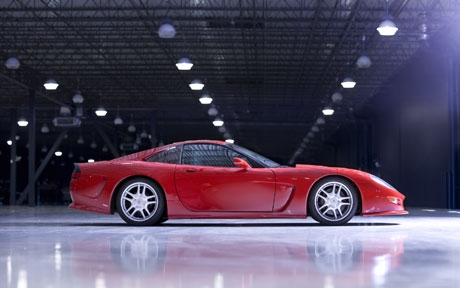Callaway has built a firm reputation for producing some of the most sophisticated and advanced Corvette-based automobiles ever to hit the road. Callaway’s C12, introduced in 1998, continued this legacy. Designed, developed, and constructed with the assistance of German engineering and development company IVM, the C12 was created from the outset to be a bespoke, high-performance car that offered its occupants a civilized interior and relaxed ride.
The Callaway C12 serial number is the same as a standard production Corvette, but the C12 is in no way standard. With aerodynamic bodywork fabricated from fiberglass, carbon fiber, and Kevlar, a massaged aluminum V8, heavily revised suspension, enormous disc brakes, and a thoughtfully upgraded interior, the Callaway C12 is a custom-built American supercar. It is so different from its Corvette base that cars sent to Europe were titled as Callaways. Very few of these exclusive cars were made, as most were built specifically to customers’ orders.
This striking Callaway C12 is the first example constructed. As such, it was featured in a number of road tests for automotive magazines. In 1998, it was on the cover of Road & Track and Motor Trend, both of which championed the car. After its press use, the car was delivered to Los Angeles Times publisher Otis Chandler.
Nearly a decade later, this C12 appears like a new car inside and out. The performance offers a purported 0–60 mph time of 4.2 seconds on the way to a top speed of nearly 190 mph. Despite its performance, the C12 is luxuriously equipped and is docile around town. Rarity, provenance, history, and performance make this Callaway a distinctive alternative to today’s top-of-the-line Corvettes.
SCM Analysis
Detailing
| Vehicle: | 1998 Callaway C12 Coupe |
| Years Produced: | 1997–2001 |
| Number Produced: | 20 |
| Original List Price: | $178,500 |
| SCM Valuation: | $75,000–$125,000 |
| Tune Up Cost: | $750 |
| Distributor Caps: | n/a |
| Chassis Number Location: | Lower left windshield corner |
| Engine Number Location: | Right front cylinder head deck |
| Website: | www.callawayownersgroup.com |
| Alternatives: | 2004–present Aston Martin DB9, 1996–2003 Ferrari 550 Maranello, 1990–99 Lamborghini Diablo |
| Investment Grade: | B |
This car sold for $57,200, including buyer’s premium, at the Gooding & Company auction in Scottsdale, Arizona, on January 17, 2009.
The concept of rebodying fine motorcars is nothing new, and some of the most esteemed coachbuilders of the 20th century earned their reputations by doing just that. Although he had other choices, Reeves Callaway chose the fifth-generation Corvette as the basis for the C12, just as he later chose the sixth-generation platform for the C16.
At the company’s Leingarten, Germany, race shop, production Corvettes were stripped of their interior, engine, suspension, and most body panels, and then rebuilt with wider suspension control arms, coil-over shocks, and Alcon brakes. A luxuriously reworked interior was also added, while the LS1 engine was sent to Connecticut for a powerful upgrade to 440 hp. But the pièce de résistance was an arresting Paul Deutschman-designed Kevlar and fiberglass body that transforms the familiar Corvette C5 shape into a genuine head-turner. Just 20 were built.
So how does history judge the Corvette-turned-Callaway now that a decade has passed? Based on this Scottsdale auction result, not so well—at least not yet.
A meteoric price plunge
Based on SCM’s own analysis, a 1998 Corvette C5 originally listing for $37,495 is worth $17,000 to $22,500 today, or 45% to 60% of its original value. But this 1998 Callaway C12, base-priced at $178,500 (with most optioned up over $200,000), retained at best 32% of its value during its recent trip across the auctioneer’s stage. Formerly owned by the late L.A. Times publisher Otis Chandler, it sold only two years ago at Gooding’s Oxnard sale in December 2006 for $121,000 (SCM# 43482). At that point it registered 782 miles; now it has over 4,000, but still…
The meteoric plunge likely has much to do with our present economic troubles, along with the availability of newer über-Corvettes like the C6 Z06 and ZR1, Pratt & Miller C6RS, and even Callaway’s own C16. Not to mention the downward value spiral that often affects high-end vehicles, late-model Ferraris included.
Some Callaways have recorded strong results—albeit in the heat of the muscle car boom in 2004—but a number have sold at auction in the $50,000 range. At the top of the list, 1988’s landmark 254-mph “Sledgehammer” C4 sold for $221,400 (SCM# 32421) and the 1998 C7R racer with FIA history brought $216,000 (SCM# 32422)—both at Barrett-Jackson Scottsdale.
“It has to be a real car, not just a showboat or an overpowered sports car,” Callaway said of the C12 in 1998. “It has to genuinely appeal to the man who is going to use it every day, who has had plenty of opportunity to have other cars in the past. He’s not buying the car for a statement. He wants power, speed, and grace from a car built by a group of men who are doing something the best way they know how.”
I don’t buy for a second that someone spending the better part of 200 grand for an audacious two-seater doesn’t want to make a statement, and one drive in the C12 proves that it may well be impossible to avoid it. In fact, driving this Callaway is like commanding the road—and the attention of every motorist and pedestrian, too. This hairy beast is two meters wide, squats lower than GM stock shares, and it goes like the devil on meth with the sewing-machine smoothness that only a well-built race motor can provide. True fact: When other drivers see the C12 closing in their mirrors, they often simply move over.
That alone may be worth the $57,200 the buyer paid for the Chandler C12. Very well bought indeed
